|
Redefining the Political Spectrum - The Rational Spectrum
By  - June 20, 2004 - June 20, 2004

One of the major problems in American political consciousness today
comes from a misrepresentation of the political spectrum. This is partly
the result of a deliberate effort to put all of America's enemies
(fascists and communists) into the same basket after World War II, and a
deliberate effort by the American "Right" to classify everything that
they oppose as "Leftist". After World War II the Republican Party was
struggling for survival and was in the process of reinventing itself.
Part of the political strategy of some Republicans was to portray the
Democratic Party of Truman and Franklin D. Roosevelt as "Red," thereby
associating "Liberalism" with "Socialism". It was a common tactic during
the 1950s to accuse Democrats of being "Communists" or "Communist
sympathizers", a tactic that worked well during the McCarthy era and has
had a lasting impact on how Americans view politics.
Though various political spectrums have been developed in America,
they all leave something to be desired and many actually reinforce
political misperceptions.
One of the first things that has to be done in order to properly
understand the full spectrum of political ideas is to correct the
popular misconception of the term "liberal" in America.
Liberal, in the classical sense of the word, simply means a "hands
off", or laissez-faire, policy. The United States is classically seen as
an example of "liberal democracy," as George Washington stated in 1790:
The Citizens of the United States of America have a right to
applaud themselves for having given to mankind examples of an
enlarged and liberal policy: a policy worthy of imitation. All
possess alike liberty of conscience and immunities of citizenship.
It is now no more that toleration is spoken of, as if it was by the
indulgence of one class of people, that another enjoyed the exercise
of their inherent natural rights.
Of course, these high ideals didn't exactly reflect the social
reality in America at that time, where slavery was still widespread and
bigotry of all kinds was still part of the social consciousness, but
nevertheless the American government created by the founders represented
a great advance for liberalism.
America was founded on the idea that government was to play a minimal
role in the affairs of society and the economy - that the job of the
government was not to provide direction for society or the economy, but
simply to maintain a "free environment" were the public could conduct
themselves as they so chose, as long as they didn't "infringe" on the
"rights" of others ("others" at that time meaning white male property owners).
This is essentially the classical concept of "liberalism" - the idea
of a laissez-faire approach to both economic and social policy.
Today in America this concept may be more often thought of as
"libertarianism." In this article I will not refer to "libertarianism";
I will be using the term "liberal" in its classical sense, because
"libertarianism" has new post-modern baggage associated with it that
makes it not truly liberal in the classical sense. Likewise, the misuse
of the term Liberal is itself part of the problem with how Americans
view the political spectrum, so this needs to addressed and corrected.
What is the popular concept of "Liberal" in America today?
The current popular concept of "Liberal" is often "Leftist" and is
associated with "big government," economic regulation, progressive
taxation, and progressive social policy, such as support for gay rights,
unlimited free speech and Affirmative Action.
With the exception of gay rights and free speech, none of these other
issues are actually "Liberal" policies in the classical sense.
Furthermore, liberalism, in either the classical sense or the current
common usage, is not "Leftist" in a full political spectrum.
Liberalism views government like a referee, whose job is to maintain
a level and equal playing field for individuals, ideas, businesses and
institutions. Government is not to take sides or support any given view
or organization. Conservatives, socialists, and others, i.e. the "Left"
and the "Right", seek to use government to promote certain agendas,
viewpoints, institutions, and interests.
This is critical to understand if one is to understand the political
landscape of the 20th century.
During the 17th and 18th century Liberalism was, of course, opposed
by the major feudal establishments: the aristocracy and the clergy. The
Liberal movement embodied the movement for the overthrow of aristocracy
and the establishment of secular representative government with
separation of Church and State. Capitalism was also directly related to
Liberalism, as businessmen sought to do away with the feudal systems of
economic control, such as mercantilism, family ownership of land rights,
and oppressive taxation used to fund the living expenses of royalty.
During the late 19th and early 20th century
Liberalism came under attack from all sides, both Left and Right. Though
"conservatives" continued to oppose Liberalism all along, "conservative"
opposition to Liberalism was rapidly diminishing throughout the 19th
century.
In fact, the hard-line positions of many of the old
"traditionalists," such as the Catholic Church (as shown below),
were leading to an even more rapid movement away from traditional
positions.
It is quite unlawful to demand, defend, or to grant unconditional
freedom of thought, or speech, of writing or worship, as if these
were so many rights given by nature to man.
-Pope Leo XIII, "Great Encyclical Letters"
1888
During the 1800s, though, "Leftist" opposition to Liberalism gained
increasing support. Leftist opposition to Liberalism was embodied
primarily in socialist movements, such as the Anarchist, Socialist and
Communist movements.
There were (and are) many "flavors" of socialist ideology that oppose
liberalism, all of which are critical of laissez-faire capitalism. They
generally consider laissez-faire capitalism to foster corruption, to be
unstable, to be exploitive, and to lead to social decay and degradation.
By the early 20th century a new "Right-wing" criticism of
liberalism began to form as well, this being fascism. Like socialism,
fascism is critical of liberalism, but fascism takes many opposing
positions to socialism in its criticism of liberalism.
Thus, by the middle of the 20th century both the "Left" and "Right"
had formed new and powerful opposition to Liberalism.
The political landscape that emerged by the mid 20th century can be
depicted as shown below, in what I call The Rational Spectrum:
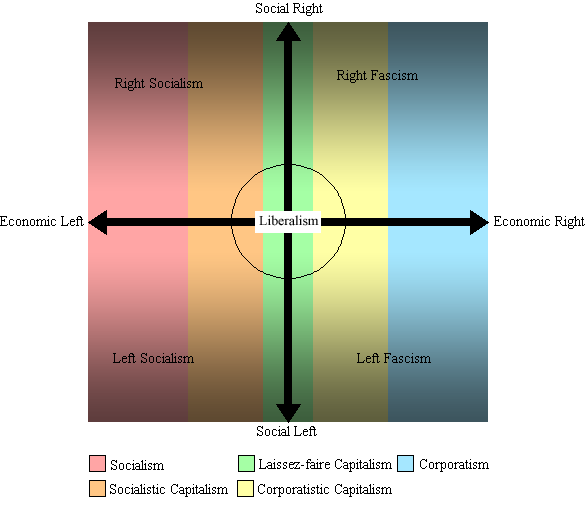
The Rational Spectrum
In this case, both Left and Right extremes of the social scale
represent authoritarian positions - regulation and authoritarianism
increase as you move away from the center.
There is another important way to view the present political spectrum
as well, which is in relation to the nature of the State. There are
three fundamental bases of power in modern society: the State, the
Church, and the Corporation. The relationships between these three
institutions of power are generally reflected within my spectrum as
shown below, these positions becoming more strongly held as you move
away from the center.
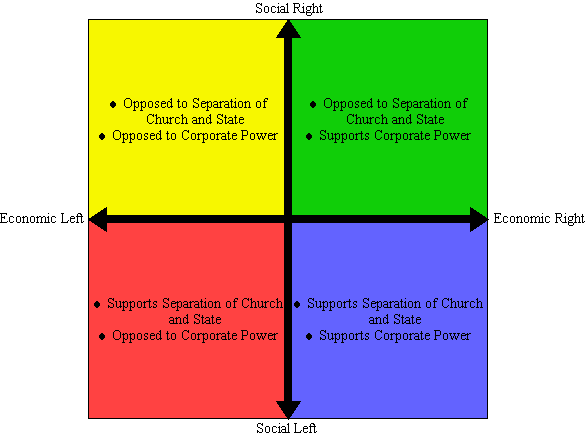
In contrast to the spectrum that I have laid out above, there are a
few other popular political spectrums.
The Nolan Chart, created by a libertarian, is a relatively popular
post-modern political spectrum:
The above are two of the most popular representations of the Nolan
Chart. As mentioned before, this spectrum lumps Communism and Fascism
together as being virtually the same. One of the biggest problems with
the Nolan political spectrum is that it still presents a "Liberal vs.
Conservative" and/or "Authoritarian vs. Libertarian (freedom loving)"
dichotomy. The Nolan system presents Libertarianism as a pinnacle of
"liberty" and places "Libertarianism" at the peak of the chart,
representing the combination of both social and economic liberty. The
use of the terms "Conservative" and "Liberal" are highly problematic in
themselves. There can in fact be conservative Leftists. Actually there
are many ways in which "Leftism" is conservative and there are many
types of Left ideology that are held by conservatives, such as the Amish
for example. Even Marxism is an arguably conservative ideology.
Additionally, this political spectrum only reinforces the improper view
of the term Liberal. In truth the terms Libertarian and Liberal have to
be synonymous on this spectrum. Libertarian ideology is laissez-faire,
and Liberal means, and has classically been understood politically to
mean, laissez-faire.
The use of terms like "freedom" and "liberty" are also problematic in
terms of trying to understand politics objectively because these are
terms that are highly propagandistic and are typically self defined. Ask
any ten different people in the world what their political views
represent and you can get ten people telling you that they stand for
freedom, while one is a Communist, one is a member of the KKK, one is a
wealthy capitalist oil tycoon, and one is a poor person on welfare. They
all have completely different views, yet to themselves they are all
"fighting for freedom".
When members of the Southern Confederacy broke away from the United
States in 1861, they did so proclaiming that they were defending their
freedom to hold slaves. What exactly is "economic freedom"? Does that
include the freedom to form a monopoly? Does a "Libertarian" regard
regulations that prevent the formation of monopolies to be higher forms
of economic freedom or are they seen as economic restrictions? What
about the free and independent formation of unions? Do laws preventing
the formation of unions count as a point in favor of "economic freedom"
or against it? Issues like these are why terms such as "freedom" are
useless in analyzing political ideology.
Another popular new spectrum is one presented by Political Compass:
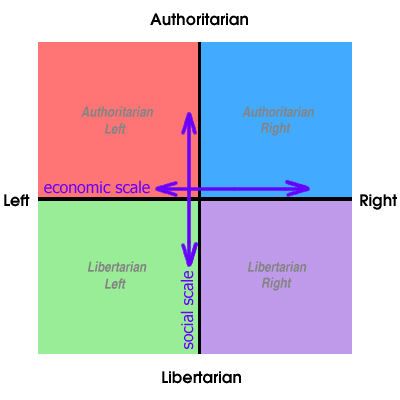
Both the Political Compass and Nolan systems present the same
fallacy, and project similar wrong ideas. Those wrong ideas being that
one side, "Left" or "Right", represents "freedom" or "lack of
restrictions", while the other represents "control" or "regulation." The
Political Compass system also labels economic left as "Collectivism" and
economic right as "Libertarianism", as shown three images down.
This is not the case though. Benito Mussolini's fascism offers the
perfect example of why these systems fail to properly depict the real
political spectrum. Mussolini was clearly right-wing in both the
economic and social sense, and at the same time none of his policies can
be considered "libertarian" in nature. Likewise, it leads to the
incorrect characterization of "Fascism" and "Communism" as being similar
or the same, when in fact the Fascists and Communists disagreed on
virtually every point, aside from the fact that they both opposed
Liberalism.
Both of these systems take a false dichotomy and simply double the
number of axis used to represent the same false dichotomy. They both
make use of the concept of "freedom" and present one side as
representing freedom, while the other represents complete lack of
freedom, but this entire scheme is misrepresentative and trivializes the
actual ideologies and positions.
In the Political Compass system for example, "Liberalism" in the
classic sense is represented by the lower right corner, what they call
"Libertarian Right."
By contrast, on the Rational Spectrum system both Left and Right
represent divergence from Liberalism. While the far social Left and far
social Right are both depicted as authoritarian in my spectrum, they are
on opposite ends of the spectrums, where they represent ideas, not
practices. Elements of the far Left and far Right, Communism and Fascism
for example, may share similar qualities but they do not share
similar ideologies nor similar objectives or views of what they would
create as a future society.
The Political Compass system can be thought of as a "folded up"
version of the Rational Spectrum. By "unfolding" the Political Compass
as shown below, you get an idea of how these two spectrums relate. In
the "unfolded" spectrum below, the terms "Left" and "Right" from the
original spectrum no longer hold their meaning. The word "Right" can be
replaced with "laissez-faire", while the word "Left" can be replaced
with "regulated". The word "Libertarian" should be replaced with the
word "Liberal".
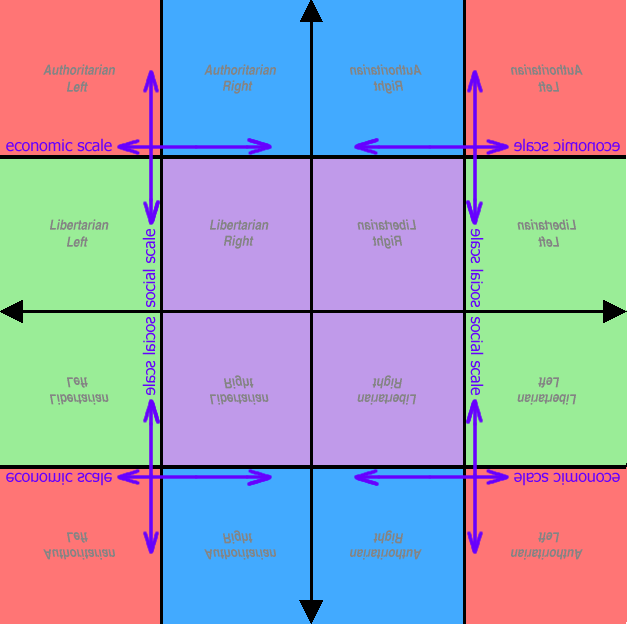
To further see how these systems differ it is helpful to look at how
various individuals may be scored with these systems.
Below is a scoring of various individuals using the Political Compass
method.
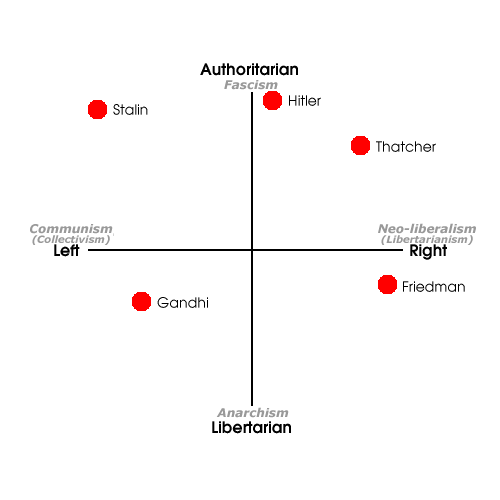
In contrast, these individuals' political positions would be
reflected differently on my spectrum, as shown below:
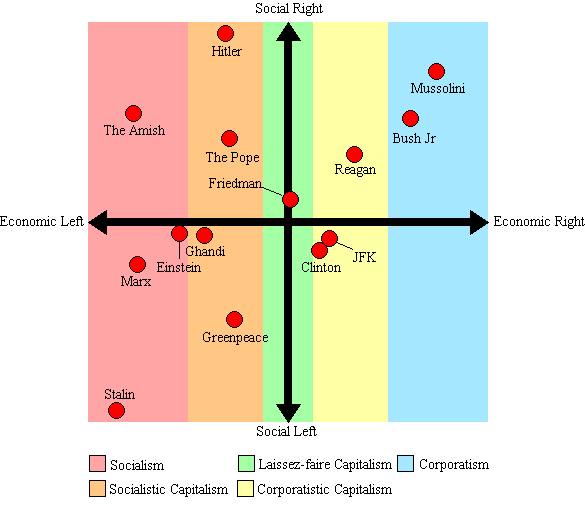
Effectively, the other two systems, the Nolan system and Political
Compass system, only measure degrees of regulation, however this is
insufficient, because it really tells you nothing about what is being
regulated, the reasoning behind the regulations, or the intended
goal. They also make the incorrect assertion that "regulations" and
"freedom" are inherently contradictory, while this is not really true -
it all depends on the nature and execution of the regulations.
For example, regulations that prevent slavery increase freedom. Rules
and regulations are not by definition restrictive on the whole, as their
net effect can be to facilitate liberty. For example, by having traffic
lights we can regulate traffic in a way to reduce congestion and
accidents, therefore the rules actually facilitate freedom of travel,
they don't restrict it.
By referring to Left and Right purely in terms of laissez-faire vs.
authoritarian, things like regulations preventing racism and regulations
enforcing racism with equal degrees cannot be properly depicted.
However, if we consider racism to be an issue that can be viewed in
terms of Left and Right, and we view anti-racist ideology as "Leftist"
and racist ideology as "Rightist", then strict regulation of racism,
either to prevent it or promote it, can be shown as authoritarian Left
and Right policy accordingly, while policy that takes no stance on
racism at all is simply Liberal. Thus Affirmative Action is seen not as
a "Liberal" program, but as a socially Leftist program that is "Left of
Liberal." Likewise, the Nazi use of the State to enforce racial genocide
is obviously not "Liberal" or even Leftist, it's an example of the
authoritarian Right.
Obviously, in this case, both Affirmative Action and the Holocaust
are examples of the use of State authority to regulate matters of race.
According to both the Political Compass and the Nolan Chart these two
policies would have to be lumped together on their political spectrums,
which plainly makes no sense.
Likewise, by viewing Left and Right as progressive vs. conservative
it insinuates that "Rightist" policy is about "keeping things the same"
and "Leftist" policy is about "change," however this ultimately makes no
sense either. Keeping things the same as what? There are thousands of
different examples of ideology from the past and this would imply that
today's "Leftist" is tomorrow's "Rightist" such that the positions are
based on tradition and not ideology. For example, when applying this
terminology to the former Soviet Union during the 1980s the Communist
hard-liners were viewed as "conservative," but obviously "conservative"
in this sense didn't mean "members of the Christian Coalition," it meant
Stalinist.
So, progressive vs. conservative and liberal vs. authoritarian do not
accurately describe "Left vs. Right."
How then are Left and Right to be viewed? What makes ideology
Leftist or Rightist?
It may be helpful to actually look back at the origin of the terms
Left and Right. The use of the terms Left and Right emerged in France
during the French Revolution, where the aristocrats sat on the right
side of the assembly and commoners sat on the left. From that time on
Right has generally been associated with ideology that favors an elite
social group and the Left has been associated with ideology that is
intended to favor "the masses."
What is important about the Rational Spectrum is that pure "Left" and
"Right" give way to a system based on Liberalism, with positions Left of
Liberal and Right of Liberal. In the Rational Spectrum Left and Right
are not so much seen in relation to each other as they are in how they
relate to Liberalism. The positions of Left and Right towards Liberalism
must first be defined and understood before Left and Right can be
contrasted with each other.
The position of the original "Right" against
original Liberalism:
The original opposition to Liberalism came from the aristocracy. In
feudal times the interests of Church, State and Commerce were all tied
together into one generally mutually supporting entity. The aristocracy
held exclusive rights to property, usually passed down by family
lineage. The aristocracy owned the land and controlled the government.
Because the aristocracy owned the land and also held rights to all the
general avenues of trade, by controlling harbors, bridges, etc, they
received much of their income from rents on land, taxes, and tariffs on
the State regulated trade.
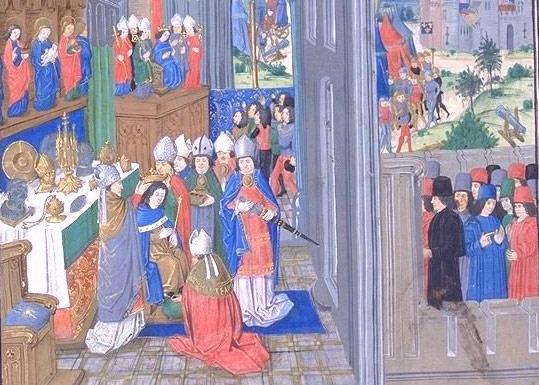
In the social sense the aristocracy had a strong relationship with
religious institutions and supported the role of the Church through the
powers of the State. Churches received tribute from the aristocracy as
well, and generally benefited from aristocratic rule. While aristocratic
culture was typically characterized by lasciviousness, wild indulgences,
vast wealth and often a lack of religious belief, the aristocrats
supported the Church because religion was seen as a way to bring order
to society and keep "the commoners" in line and subservient to the
economic interests of the aristocracy.
Prior to the revolution in France this was formally institutionalized
within the French political system. Though the king of France held
significant power, there were also legislative assemblies which voted on
matters of State. The constituents were divided into three groups: the
First Estate (which represented the Clergy), the Second Estate (which
represented the Nobles), and the Third Estate (which represented the
commoners). The Third Estate represented about 98% of the population,
however, each of the Estates had an equal number of votes, and thus the
Third Estate could be, and almost always was, outvoted by the First and
Second Estates, who cooperated together to overrule the Third Estate.
The economic systems supported by the aristocratic Right were those
of feudalism and mercantilism. Feudalism describes a wide range of
economic and social systems, but feudal economic systems were generally
based on noble systems of land ownership, whereby peasants lived and
worked on land owned ultimately by a king or emperor. These systems were
often based on pyramid type schemes, whereby a king allocated land to a
certain few members of royalty, and each of those people allocated their
land to others, and so on and so forth.
The Churches typically owned between 10% and 30% of the land in
countries throughout Europe and paid no taxes. Virtually all taxation
was paid by the working classes. The peasants worked the land and paid
rents and taxes to their landlord, who then paid a share of the fees
that they collected to those above them, and so forth up the chain.
Aristocrats generally never had to do any kind of work, although some
chose to do so. Education was generally only for the aristocracy and the
only other means of receiving an education was typically through the
Catholic Church and was reserved for upper-class commoners.
In the Rights of Man, written during the
French Revolution, Thomas Paine noted:
The aristocracy are not the farmers who work the land, and raise
the produce, but are the mere consumers of the rent; and when
compared with the active world, are the drones, a seraglio of males,
who neither collect the honey nor form the hive, but exist only for
lazy enjoyment.
Mercantilism was characterized by State governed trade. All trade was
managed by the State and merchants engaged in trade on behalf of the
State according to quotas. A certain portion, often a large portion, of
their profits in trade went to the aristocracy who governed the trade
systems. Merchants did not control production, instead they bought goods
from craftsmen and other laborers. They then brought these goods to
market and sold them.
The Liberals, the original so-called "Leftists", were those who
opposed these social and economic systems and called for the
establishment of democratic systems of government, with separation of
Church and State, freedom of the press, and the establishment of
"free-enterprise". The free-enterprise system was seen as an economic
system where owners of property were free to engage in business however
they so chose without the interference of the State and without having
to pay tribute to the State in order to conduct business. In this case,
however, "the State" was ultimately the king and his nobility, and the
tribute went not to paying for public programs, but instead to
supporting the Churches and the extravagant living conditions of the
aristocracy. Thus, when reading much of the literature from the 17th and
18th century, one has to keep in mind that anger directed towards "the
government" is anger directed towards aristocracy and the Church.
The "Right" conservatives were the members of the establishment who
opposed these changes and wanted to maintain a theocratic system of
government based on royalty, where the majority working-class people
were disenfranchised and paid taxes and fees to the wealthy aristocracy.
With the adoption of free-enterprise the "Merchant class" developed
into the "Capitalist class" and began owning and controlling commodity
production, thereby putting large numbers of craftsmen out of work. This
was the beginning of the Industrial Revolution, which resulted in the
widespread adoption of wage labor.
Early "Left" opposition to Liberalism
Soon after the Liberal Democratic revolutions took place in America
and France a "Left" opposition to the new Liberal society took place.
This was much, much stronger in Old World Europe where the countries
were already developed and a major social structure was already in
place. Left opposition to Liberalism never gained major significance in
early America primarily because the country was so vast and undeveloped
and there was no significant underclass in America among white society.
America was to where many of the oppressed of Europe fled to gain
freedom, as opposed to staying in Europe and trying to change the system
there. Since the vast majority of America was untamed wilderness, class
antagonisms based on ownership of land and property hardly existed in
America.
In Europe, however, it was a much different story and this is why a
Left opposition to Liberalism quickly and strongly formed there.
Gerrard Winstanley of
England provided some of the early roots of what would later become the
Leftist movement of the 1800s. In 1649 he wrote:
In the beginning of Time, the great Creator Reason, made the Earth
to be a Common Treasury, to preserve Beasts, Birds, Fishes, and Man,
the lord that was to govern this Creation; for Man had Domination
given to him, over the Beasts, Birds, and Fishes; but not one word
was spoken in the beginning, That one branch of mankind should rule
over another...
And hereupon, The Earth (which was made to be a Common Treasury of
relief for all, both Beasts and Men) was hedged in to In-closures by
the teachers and rulers, and the others were made Servants and
Slaves: And that Earth that is within this Creation made a Common
Store-house for all, is bought and sold, and kept in the hands of a
few, whereby the great Creator is mightily dishonoured, as if he
were a respector of persons, delighting in the comfortable
Livelihoods of some, and rejoycing in the miserable povertie and
straits of others. From the beginning it was not so.
The commonly known and most influential movements of Left opposition
to Liberalism are the Socialist, Anarchist, and Communist movements. All
of these movements to some degree have their roots among French
socialist ideology that developed after the French Revolution and/or the
British workers movements of the 1700s that took shape after the
establishment of a constitutional monarchy in England.
Even at this early stage, and perhaps even more-so at this early
stage, Leftist ideology was extremely vast and covered a wide range of
ideas and positions, and therefore it is impossible for me to completely
categorize the early Left ideological positions here.
Generally speaking though, the early Left opposition to Liberalism
was rooted in protecting traditional roles of workers in society, such
as guilds, craftsmen and farming communities, from the effects of the
Industrial Revolution. The early Left focused mostly on workers'
movements and working class interests - the working class being
non-propertied people who had to constantly work for a living, i.e.
those that had become wage laborers.
Overall, one of the main ideological positions of the Left has always
been that of equality. Leftist positions from the beginning have
generally been tied to the idea that "all men are created equal." It is
this idea of equality that pervades virtually all Leftist ideology.
The most common and fundamental element of Left opposition to
Liberalism is the issue of labor and property. Another major criticism
of Liberal society by the Left was on the issue of democracy. Left
criticism of Liberal democracy centered on pointing out that Liberal
democracy was really just a democracy for the wealthy, and that it
excluded the interests of women, non-propertied men, and non-whites.
Another of the characteristics of the early Left was a tendency to be
opposed to technological progress. The early Left movements were
dominated by peasants, miners, and craftsmen, many of whom were being
displaced by the changes brought on by industrialization and forced to
work in factories at wages well below their traditional earnings, thus
adopting much lower living standards. Some early Leftists were involved
in such activities as vandalizing factories and destroying machines,
which they saw as a threat to their humanity and livelihood.
The most well known of these movements is known as Luddism, named after Ned
Ludd. The Luddites were organized groups of workers in England who
opposed "free market" practices and supported retaining the traditional
pricing customs of the community. The Luddites raided factories and
sabotaged machinery.
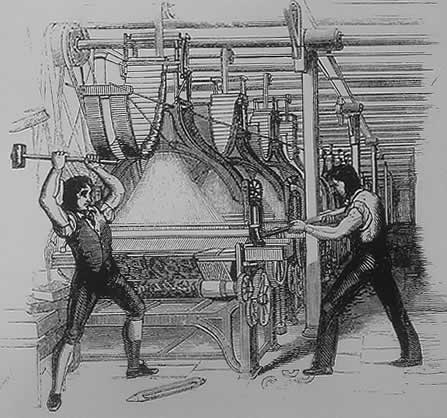
To many in the early Left movement, Liberalism only represented an
exchange of masters - trading the royal aristocracy for a new type of
aristocracy.
As the Industrial Revolution progressed in Europe these workers'
movements gained in strength and support as the disparity between rich
and poor grew during the 1800s while unemployment, child labor and
poverty increased.
In early America these issues were of lesser importance. In America
the major issue of the Left was that of slavery. The Left movements in
America were very different from those of Europe because slaves in
America were so disenfranchised that they themselves were
effectively unable to fight for their own rights in a constructive
manner. In Europe Left movements made a strong point of the fact that
any oppressed class was responsible for its own emancipation and that it
was impossible to expect or depend on the actions of an enfranchised
class to come to the aid of the oppressed. For this reason, European
Leftist movements often strongly promoted revolutionary tactics,
believing reform to be impossible because reform by definition meant
collaboration with the dominant establishment.
Because of the situation of blacks in America it was virtually
impossible for blacks to emancipate themselves. Thus Left movements in
America, which naturally coalesced around this issue, were much more
reformist in nature, because they were movements of generally
enfranchised people seeking to help a disenfranchised minority, as
opposed to the Leftist movements of Europe which were considered to be
movements of a disenfranchised majority seeking to overthrow the power
of an enfranchised minority.
By the mid 1800s there was a very wide variety of Left opposition to
Liberal capitalism and Liberal society. Again there were some major
differences between American and European Leftist groups. In America a
significant number of groups who opposed Liberal capitalism were
Christian based groups who, due to the nature of the country and the
availability of land, often went off on their own to form secluded
communes. Some of these groups included religious groups related to the
Anabaptists, such and the Mennonites, Quakers and the Amish.
While it is impossible to completely categorize the views of these
different groups, they generally opposed slavery, were pacifists,
strongly supported the idea of human equality and democracy, and they
believed in simple lifestyles based on shared community property and
shared community interests. They opposed banking and the charging of
interest on money lending, and they opposed government support for, or
involvement with, churches and religious organizations. While they
technically supported separation of Church and State at the national
level, religion was a central aspect of their own societies, and so
within their own communities Church and Community, which was like its
own "mini-State", were definitely united.
These could effectively be categorized as socialist Christian groups.
Many Quakers in particular became prominent advocates for women's
suffrage, such as Susan B. Anthony and Elizabeth Caddy Stanton.
While many Quakers were vocal opponents of slavery and supporters of
women's rights, these groups had little overall impact on society in the
economic sense because they were largely reclusive groups that formed
their own independent communities and were seldom active on a larger
scale. While the practices regarding labor and property within their own
groups was very much Leftist in nature, they did not advocate these
practices at the national level or seek to become involved in larger
labor movements.
In Europe, however, the situation was somewhat different. While all
of the above mentioned groups came to America from Europe, mostly from
the Germanic regions, the Left movement in Europe was of a largely
different character, and by the mid 1800s Marxism had become a major
factor among the European Left.
Marxist opposition to Liberalism
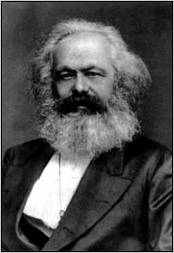
While it would not be true to say that Marxism represents all views
of the modern Left, Marxism had an undeniably enormous impact on the
Left during the 19th and 20th centuries.
Though many in America today associate the Left with both Marxism and
"Liberalism" (this is largely due to the actions of the House
Un-American Activities Committee and Joseph McCarthy in the 1950s, who
accused many members of the Roosevelt and Truman administration, who
called themselves Liberals, of being Communists), Marxism was actually
extremely critical of Liberal society. The main focus of Marxism
politically was in fact opposition to Liberalism.
Marxism is opposed to Liberal "middle-class" society, referred to by
Marxists as bourgeois (pronounced boor-zhwa') society, on a variety of
levels, all of which are ultimately related.
What then are the Marxist positions in opposition to Liberalism?
Fundamentally Marx, like Adam Smith, argued that all value is a product of labor and
human social relations. Marx argued that value that is created in an
economy is primarily the product of human beings doing work and the
exchange of that work with other human beings. Other value is created by
nature without human effort. From this Marx made a
variety of other arguments.
Marx argued that capitalists are those who own rights to the value
that is created by workers, and that capitalists are thereby depriving
workers of the value of their own labor - that profits are, in effect,
just a new name for the taxes once levied by the feudal aristocracy.
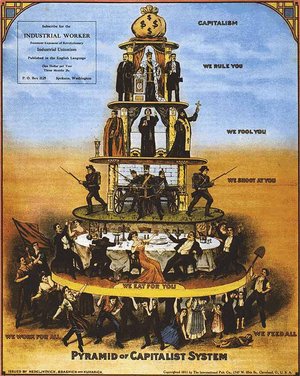
Marx also argued that the exchange of commodities actually represents
not an exchange of objects, but a pattern of human relationships. He
argued that in Liberal society the human basis of labor and creation of
value is masked and disregarded in such a way that members of society
become both "materialistic" and ignorant of the human cost of
production, thereby alienating members of society from one another. This
leads to individuals becoming self-centered, and to the objectification
of themselves and others.
Marx called this commodity fetishism, and he argued that commodity
fetishism led people to view value as a product of objects themselves
and not as a product of labor and society. This is what Marx argued that
value really was, a product of labor and social relations between
people. Marx, like Adam Smith and David Ricardo before him, separated
out "use-value" and "exchange-value".
Use-value is the value of an object for satisfying some want or need,
for example the value of a car is that it can transport people from
place to place. This value is the product of labor and/or nature. Marx
based this definition of value on John Locke's and Adam Smith's
definitions of value, both of whom stated that labor is the primary
means by which value is created. Locke argued that value that is
inherent in nature is common property since it is not created by man.
All other use-value that is not inherent in nature is the product of
labor, and is rightfully the property of the person who labored to
create it.
Exchange-value is the value that a commodity has in a market, which
is a socially created value. Exchange-value is the value that
commodities are judged to have in relationship to other commodities. One
basket is worth two eggs; three cows are worth a horse and wagon; a pair
of shoes is worth $30, etc. In any economic exchange, use-value is
resolved to exchange-value by the parties involved in the exchange.
One of the major contributions of Marx to Leftism was his support for
technological progress and modernism. Prior to Marx many Leftists saw
technology as bad because it was technology that was subordinating them
socially, however, Marx embraced technological advance and supported
elements of capitalism as a form of progress over feudalism. Marx was
instrumental in shifting the Left from being anti-industry to
pro-industry. For Marx, the objective was not for workers to oppose
industrialization, but rather for workers to take hold of
industrialization, embrace it, and control it themselves. Marx saw
Communism as the democratization of industrialization.
Marx pointed out that capitalism increased the socialization
of production, i.e. the interactions and interdependencies between human
beings throughout the production process. At the same time, capitalism
restricted ownership of socially created value to a few. Therefore
capitalists acquire unto themselves value that is created by society,
and this is the key to the way in which capitalists are able to amass
great wealth in a short period of time - they are accumulating socially
created value that is produced by millions of people around the world.
In relation to the effects of the capitalist mode of production on
society Marx stated in 1844:
We have seen what significance, given socialism, the wealth of
human needs acquires, and what significance, therefore, both a new
mode of production and a new object of production obtain: a new
manifestation of the forces of human nature and a new enrichment of
human nature.
Under private property their significance is reversed: every person
speculates on creating a new need in another, so as to drive him to
fresh sacrifice, to place him in a new dependence and to seduce him
into a new mode of enjoyment and therefore economic ruin. Each tries
to establish over the other an alien power, so as thereby to find
satisfaction of his own selfish need. The increase in the quantity
of objects is therefore accompanied by an extension of the realm of
the alien powers to which man is subjected, and every new product
represents a new potentiality of mutual swindling and mutual
plundering. Man becomes ever poorer as man, his need for money
becomes ever greater if he wants to master the hostile power. The
power of his money declines in inverse proportion to the increase in
the volume of production: that is, his neediness grows as the power
of money increases.
Marx argued that in liberal capitalist societies people would
increasingly relate to one another not as human beings, but instead,
because of commodity fetishism, they would relate to one another through
objects. Marx argued that people in capitalist society viewed
one-another not from a personal basis, but instead people were viewed
based on their possessions and what they owned. Marx noted that
commodity fetishism resulted in people imparting a supernatural type of
quality to objects and believing that commodities actually made them "a
better person," or enhanced "who they were" in some fashion.
On the issue of democracy Marx was not just an advocate of democracy,
but argued that it was essential that democracy be fully inclusive of
everyone. During Marx's life the majority of people were not legally
included in the democratic process in so-called democratic countries.
Women didn't have democratic rights and the working class was
largely disenfranchised from the democratic process, either officially
or effectively, and of course America was still home to one of the
largest slavery systems in the history of the world.
Marx argued, therefore, that the disenfranchised majority would have
to seize control through revolutionary measures and institute a
"democratic dictatorship." In this manner he considered a "dictatorship
of the working-class" to be merely the same thing as what he considered
to be the existing dictatorship of the capitalist class. He basically
argued that democracy as it existed was exclusive to a certain class of
people and that this represented a "class dictatorship."
He argued that the bourgeois class was able to come to power and
protect its own interests by establishing a class dictatorship when it
overthrew the feudal system and the powers of the aristocracy, and that
the working-class would have to follow the same pattern, taking control
and overthrowing the powers of the capitalist class. After the interests
of the working class had been secured, then complete and total democracy
should be restored, and at that time, for the first time, true democracy
would exist. Marx argued that democratic concessions by the bourgeois
may occur, but that they would only occur once their own class interests
had been secured, thus ultimately continuing to alienate the working
class.
Marx gave relatively little attention to "conservatives" of his day.
This is because, for the most part, conservatives were not in power, as
they had been disenfranchised by the Liberal revolutions. Religion was
the area that brought Marx into the most direct conflict with
"conservative" views, but Marx was quick to recognize and point out that
both liberal and conservative society was based on an acceptance of
religious ideology. Thus, his criticism of religion applied to both the
liberal and conservative views of the time.
While some liberals were critical of religion, the Marxist view and
criticism of religion was quite distinct and worthy of note in
understanding the difference between Liberal, Marxist Left, and Right
views on religion.
Marx was not opposed to "Christian values", in fact Marx saw
Christianity as a generally positive ideology and viewed the early
Christian movement as a socialist movement of its day. Marx's criticism
of Christianity was not that Christian values were bad, but rather that
Christianity, and all religions, were man-made constructs. Marx
criticized religion not as something that had no role in society and
should simply be discarded, but rather that religion played an important
role in society, however since all religions were man-made and based on
primitive concepts about reality, the objective was not merely to
abolish religion, but rather to replace the role of religion in society
with an ethical system based on philosophy and scientifically understood
principles.
For this reason Marxism seems to share qualities of conservatism in
some ways.
This again is where Marx was in conflict with liberal society.
In 1844 Marx wrote:
Luther, we grant, overcame bondage out of devotion by replacing it
by bondage out of conviction. He shattered faith in authority
because he restored the authority of faith. He turned priests into
laymen because he turned laymen into priests. He freed man from
outer religiosity because he made religiosity the inner man. He
freed the body from chains because he enchained the heart.
But, if Protestantism was not the true solution of the problem, it
was at least the true setting of it. It was no longer a case of the
layman's struggle against the priest outside himself but of
his struggle against his own priest inside himself, his
priestly nature. And if the Protestant transformation of the German
layman into priests emancipated the lay popes, the princes, with the
whole of their priestly clique, the privileged and philistines, the
philosophical transformation of priestly Germans into men will
emancipate the people.
(Note: Some 90 years later Adolph Hitler
would base his political movement on opposition to Marxism and a
call for a religious revival in Germany.)
Liberal society was generally supportive of religion and called for
"religious liberty", effectively embracing the idea of "equality of all
religious views". The conservatives, of course, firmly supported
religion, however they supported only their own religious views and did
not believe in tolerance of other religions, instead supporting
State-enforced religion.
The Protestant Reformation effectively represented a "liberalizing"
of religion, making religion individual and personal, and it is no
coincidence that the movement for Liberal Democracy and society based on
individuality coincided with the Protestant Reformation.
Marx was critical of liberal society in that it still supported
"idealism", which is the basis of religious belief. Marx noted that
while "religious freedom" was increasing, what it was really causing was
increased confusion and a lack of social cohesion, leading to the
continuation of all manner of superstitious views and beliefs.
Vladimir Lenin later commented on this in 1913 writing:
The philosophy of Marxism is materialism. Throughout the
modern history of Europe, and especially at the end of the
eighteenth century in France, which was the scene of a decisive
battle against every kind of medieval rubbish, against feudalism in
institutions and ideas, materialism has proved to be the only
philosophy that is consistent, true to all the teachings of natural
science and hostile to superstition, bigotry, etc. The enemies of
democracy therefore tried in every way to "refute," undermine and
defame materialism, and advocated various forms of philosophical
idealism, which always, in one way or another, amounts to an
advocacy or support of religion.
Marx and Engels always defended philosophical materialism in the
most determined manner and repeatedly explained the profound error
of every deviation from this basis.
The problem with secular liberalism was that even if it did not
support religion, it did not refute it either. While elements of secular
liberal society did work towards the diminishing of religious beliefs,
they failed to provide a solid philosophical replacement for religion.
Marxism on the other hand, made a positive refutation of all religion
and sought to replace the role of religion in society with philosophy,
science, and ethics.
The Liberal position on religion was for the State to remain neutral,
and neither support religion nor oppose it. The Conservative position
was to use the State to support religion. The Marxist position was to
use the State to oppose religion.
The rise of the modern Right
Throughout the 1800s the primary political conflict was between the
Left and Liberalism, because the "old conservatives" had been largely
vanquished and their base of power almost completely undermined. Old
conservatism was rooted in theocracy and State control over the economy
and society in ways that supported the wealth of the aristocracy.
Capitalism was the product of the liberal democratic revolutions, and
by the late 1800s the capitalists of America and Europe were easily the
most powerful members of society and thus represented the new
establishment and the basis of power in society.
By the beginning of the 20th century a "new Right" was beginning to
form however.
The new Right, like the old Right, was opposed to both Liberalism and
the Left as well, especially Marxism.
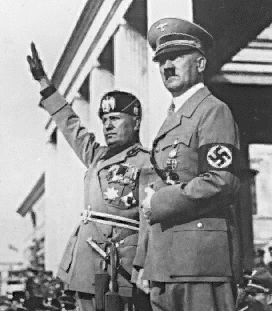
The name for strongest element of this new Right movement was
"Fascism", as Mussolini stated in 1932:
If it is admitted that the nineteenth century has been the
century of Socialism, Liberalism and Democracy, it does not follow
that the twentieth must also be the century of Liberalism, Socialism
and Democracy. Political doctrines pass; peoples remain. It is to be
expected that this century may be that of authority, a century of
the "Right," a Fascist century.
In 1935 he went on to write:
The foundation of Fascism is the conception of the State, its
character, its duty, and its aim. Fascism conceives of the State as
an absolute, in comparison with which all individuals or groups are
relative, only to be conceived of in their relation to the State.
The "Liberal State" is not a directing force, guiding the play and
development (both material and spiritual) of a collective body, but
merely a force limited to the function of recording results. On the
other hand, the Fascist State is itself conscious, and has itself a
will and a personality - thus it may be called the "ethical"
State...
The individual in the Fascist State is not annulled but rather
multiplied, just in the same way that a soldier in a regiment is not
diminished but rather increased by the number of his comrades. The
Fascist State organizes the nation, but leaves a sufficient margin
of liberty to the individual; the latter is deprived of all useless
and possibly harmful freedom, but retains what is essential; the
deciding power in this question cannot be the individual, but the
State alone...
The Fascist State is an embodied will to power and government, the
idea of force in action. According to Fascism, government is not so
much a thing to be expressed in territorial or military terms as in
terms of morality and spirit. It is an empire - that is to say, a
nation which directly or indirectly rules other nations without the
need of conquering a single square yard of territory.
Fascism cannot be said to have been a truly "conservative" movement
per se, but it did incorporate elements of conservatism and it did ally
itself with elements of the "old Right."
Fascism was not purely conservative because fascists embraced new
technology and new ideology and the fascists looked to the future, not
the past. Instead of saying "we have to get back to the old ways," they
said "we have to develop a new system." Additionally, fascism was based
on capitalist economy, unlike the feudal systems of the "old
Right". This is why fascism was a "new Right" movement.
Socialism was seen as a working-class, or under-class, movement and
Liberalism was then seen to be the ideology supported by the wealthy
elite class and capitalism. Fascism was based on a middle-class movement
and gained its initial base of support largely from middle-class workers
and small business owners, people who both opposed the "Left" and also
opposed the existing wealthy establishment as well.
The Liberal revolutions had effectively separated the realms of
Church from State and Commerce from State. That was what the Liberal
revolutions were all about - eliminating the State control over commerce
(feudalism and mercantilism) and State control over religion (theocracy)
(or religious control over the State).
This was in many ways an indirect result of the Protestant movement. The Catholic
Church was the institution that had for over 1,000 years been the
central authority in Western civilization that controlled the State, and
thereby controlled both commerce and religion. Even though many
Protestants were conservative, they broke the Catholic system of social
control, thereby facilitating liberalism.
The result of the Liberal revolutions, even in Catholic-dominated
France, was that there was a massive move away from the Catholic Church,
and Protestants had declared an almost ruthless war against Catholicism,
many of them seeking the eventual complete abolition of the Catholic
Church.
Protestant hatred of Catholicism was very profound. After all, many
Protestants in the 17th and 18th centuries suffered death and
persecution from the Catholic Church, and even in the 19th century the
sentiment was still strong that Catholicism was not real Christianity,
but in fact was a form of enslavement of mankind that twisted and abused
"true Christianity."
Because of this the Catholic Church was suffering massive losses of
membership throughout the 19th century and into the early 20th century.
However, as the Communist and Socialist movements progressed, and as
atheism became increasingly popular during the early part of the 20th
century, Protestants and Catholics began to reconcile their differences
and direct their energies less towards attacking each other and instead
towards attacking secularism, Communism and Liberalism.
This was one of the ways in which the Fascists connected with the
"old Right", because the Fascists allied with the Catholic Church and
re-embraced the merger of Church and State. Under the old system,
however, it was largely the Church that had power over the State, but
with the "new Right" it was the State that dominated the Church. In 1929
Mussolini signed the Lateran Treaty with Pope Pius XI, which established
Catholicism as the official State religion of Italy.
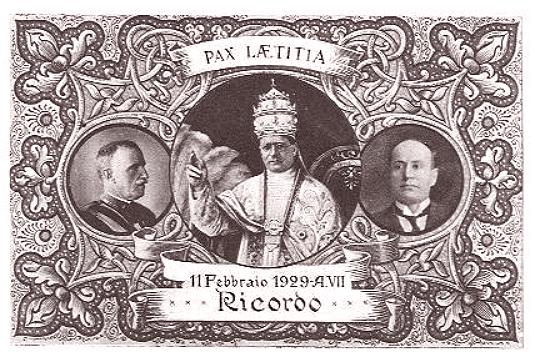
In 1937 Pope Pius XI wrote the Encyclical Letter On Atheistic
Communism, in which he denounced Communism and any nation that
would ally itself with the Soviet Union. In it he stated:
If we would explain the blind acceptance of Communism by so many
thousands of workmen, we must remember that the way had been already
prepared for it by the religious and moral destitution in which
wage-earners had been left by liberal economics. Even on Sundays and
holy days, labor-shifts were given no time to attend to their
essential religious duties. No one thought of building churches
within convenient distance of factories, nor of facilitating the
work of the priest. On the contrary, laicism (separation of Church
and State) was actively and persistently promoted, with the result
that we are now reaping the fruits of the errors so often denounced
by Our Predecessors and by Ourselves.
Here is it understood that "liberal economics" has its traditional
meaning which is "free market capitalism".
And so, the "new Right" movement represented a re-joining of Church,
State, and Commerce into what Mussolini called, the "ethical corporate
State", as Mussolini noted:
Fascism should more appropriately be called Corporatism because
it is a merger of State and corporate power.
Though the "new Right", i.e. Fascism (reemerging today as
neo-conservatism), drew its base of support from the middle-class and
was viewed as a middle-class movement, due to its extreme involvement in
industry and its strong opposition to Communism, which was perceived as
a very real threat to private wealth in Europe, Fascism quickly drew the
support of many of the world's wealthy elite as well, especially during
the time of its rise, which was during a global economic depression.
While the fascists continued to speak about support for the
middle-class, in fact they were increasingly aligning themselves with
the interests of wealthy capitalists.
This "new Right", then, represented cooperation between the State and
private industry in ways that were mutually beneficial to both private
industry and the State. In this case, State involvement in industry was
not something that was done to try and help the working-class, but
indeed it was the opposite: the State became a tool for protecting the
interests of corporations.
The emergence of post-modern politics
The major political positions have now been outlined: Liberalism, the
original Right opposition to Liberalism, the Left opposition to
Liberalism, and the new Right opposition to both Liberalism and the
Left.
These positions form the foundation of the present political
spectrum, and as you can see, there is opposition to both social and
economic Liberalism from every direction.
There is a great deal of political confusion in America today, in
part because the American view of the political spectrum is flawed.
The same thing happened in America after World War II that happened
in Europe before World War II: The threat of Communism resulted in the
Church, State, and Commerce aligning interests to support each other, and
most importantly, the interests of the wealthy elite.
An American "Right" emerged that ideologically claims to support both
free-market capitalism, individuality, traditional values, and
Christianity. Because of the persistent opposition in American society
to Soviet Communism, and because of FDR's New Deal, Americans tend to
view all government involvement in Commerce as "anti-business," however
this is actually not the case.
Additionally, FDR proclaimed himself to be a "Liberal" and thus FDR's
creation of "big government" associated the word "Liberal" in America
with "big government", although "Liberal" and "big government" really
have nothing at all to do with each other.
These facts combine to promote the view that "Liberals" are anti-free
market capitalism, or rather that free-market capitalists are
"anti-Liberal".
Furthermore the view in America is that "Liberalism" is "Leftism".
Now it has to be explained why these views are all wrong and actually
mask political and economic realities.
Free-market capitalism and Liberalism (in both the economic and
social sense) go hand in hand with each other. It is the fact that
people fail to understand this that makes the current "Conservative"
movement in America so misdirected. Capitalism is actually the driving
force behind the breakdown of all of the old bonds of society.
Many conservatives in America today believe that any government
involvement in anything is some form of "Socialism", and they then
support the interests of private industry to almost absurd extremes. In
fact, however, government is essential for the support of the wealthy,
and naturally acts to benefit the richest members of society and to
facilitate economic disparity, as Adam Smith noted in The Wealth of
Nations in 1776:
It is in the age of shepherds, in the second period of society,
that the inequality of fortune first begins to take place, and
introduces among men a degree of authority and subordination which
could not possibly exist before. It thereby introduces some degree
of that civil government which is indispensably necessary for its
own preservation: and it seems to do this naturally, and even
independent of the consideration of that necessity. The
consideration of that necessity comes no doubt afterwards to
contribute very much to maintain and secure that authority and
subordination. The rich, in particular, are necessarily interested
to support that order of things which can alone secure them in the
possession of their own advantages. Men of inferior wealth combine
to defend those of superior wealth in the possession of their
property, in order that men of superior wealth may combine to defend
them in the possession of theirs. All the inferior shepherds and
herdsmen feel that the security of their own herds and flocks
depends upon the security of those of the great shepherd or
herdsman; that the maintenance of their lesser authority depends
upon that of his greater authority, and that upon their
subordination to him depends his power of keeping their inferiors in
subordination to them. They constitute a sort of little nobility,
who feel themselves interested to defend the property and to support
the authority of their own little sovereign in order that he may be
able to defend their property and to support their authority. Civil
government, so far as it is instituted for the security of property,
is in reality instituted for the defence of the rich against the
poor, or of those who have some property against those who have none
at all.
While supporting "capitalism" conservatives denounce social
liberalism, yet they fail to recognize that market capitalism promotes,
and benefits from, social liberalism. They support capitalism and then
complain about the effects of capitalism without seeing the relationship
between the two things.
Capitalism and Liberalism have always gone hand in hand, but the
failure to recognize this, combined with the past 50 years of
anti-Leftist sentiment in America, has resulted in American politics
shifting further and further to the economic Right into the realm of
Corporatism - State support for corporations and the wealthy elite at
the expense of the working-class.
The result is that American politics today can be depicted as shown
below in relation to the Rational Spectrum, with the pinkish area
representing establishment political ideology:
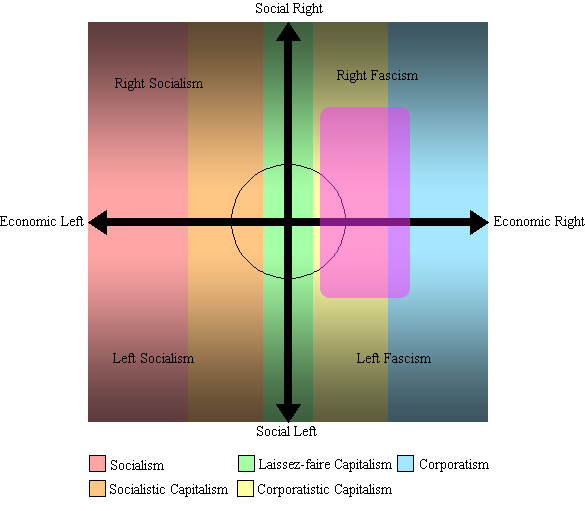
American politics today is very much shifted to the Right
economically and socially, yet American society in general is relatively
liberal in the social sense.
"Conservative" citizens who support right-wing politicians are in
fact contributing to the very problems that they are trying to oppose,
and the result is that as the economics shift more and more to the
Right, the social situation becomes more and more liberal. The
conservatives then keep pressing more and more to the Right, thinking
that that is the answer, but in fact it is not.
The fact is that social liberalism is beneficial to corporations. The
more liberal that society is, the more opportunities there are for
making money, and, as Marx stated:
Under private property... every person speculates on creating a new
need in another, so as to drive him to fresh sacrifice, to place him
in a new dependence and to seduce him into a new mode of enjoyment
and therefore economic ruin. Each tries to establish over the other
an alien power, so as thereby to find satisfaction of his own
selfish need.
This is where the fundamental break between American society and
religious conservatism occurs.
Most major religions, Christianity, Islam, Buddhism, Hinduism, and
others, are based on the idea of limiting an individual's desires.
Fundamentally, religious societies are typically societies where people
are encouraged to control their desires and limit their possessions and
worldliness.
Capitalist society, though, is based on the exact opposite of that.
Despite the fact that FDR's New Deal appeared to be anti-business on its
face, and despite the fact that the Keynesian economics of the post-WWII
era in America relied on government intervention in the economy, this
intervention was all designed to promote capitalism, and the means of
doing that was through the promotion of consumerism, as the 1995 article If the GDP is Up, Why is America Down?
states:
But the biggest change was in who "the people" now were. Because
the Keynesian approach saw consumption as the drive train of
prosperity, Washington collectively looked at the public in those
terms as well. They were no longer primarily farmers, workers,
businesspeople--that is, producers. Rather, they were consumers,
whose spending was a solemn national duty for the purpose of warding
off the return of the dreaded Depression. Our young men had marched
off to war; now Americans were marching off to the malls that
eventually covered the land.
This fundamental element of the American economy has gone unchanged,
and in fact has only become increasingly important since the first
implementation of Keynesian economics in America. Though we now operate
under the Supply-Side model of the Reagan administration, not Keynesian
economics, what Reaganomics did was to amplify the role of consumerism
and do away with the elements of social responsibility found in the
earlier Keynesian system.
Liberalism is not Leftist, and Liberalism is not anti-capitalist.
This is why it is quite obvious that places like Las Vegas are in fact
both extremely liberal and extremely capitalistic. Capitalism promotes
social liberalism, it always has. Corporatism protects the interests of
capitalists by using the State to regulate the economy in favor of the
wealthy establishment, similar to the way that the State was used to
promote the interests of the aristocracy 300 years ago prior to the
liberal democratic revolutions that swept Western Civilization.
Prior to the development of capitalism the interests of the wealthy
elite were protected by promoting cultures of self sacrifice and
rejection of worldliness among the working classes. This is why the
major organized religions of the world have this theme, because
religions have generally been tools of the State to protect the
interests of the establishment elite class.
However, with the development of capitalism a revolutionary new way
of viewing workers came into being. Instead of seeing workers as being
slave like masses that should consume as little as possible so that the
fruits of their labor could instead be enjoyed by the ruling class, the
consumption of goods by workers, now that an economic system had been
established whereby profits from commerce were the principle means of
income for the wealthy establishment, was seen as a means to fuel even
more generation of profits. Because of this, the more that the masses
consume, the wealthier the wealthy get because the wealthy get a
"percentage" of all consumption. Thus social Liberalism now favors the
wealthy establishment, as opposed to the past under feudal systems of
production, where social conservatism and pragmatism meant that more was
"left over" at the end of the day for the wealthy to acquire when
workers were satisfied by a meager and humble existence.
This is why viewing State intervention and regulation as "Leftist by
definition" is completely wrong. Both Left and Right favor government
intervention in both the economy and society, but for completely
different reasons: the Left to protect the interests of the
working-class, the Right to protect the interests of the wealthy
establishment. The American "Conservative Right", the citizens that
align themselves with this movement that is, are increasingly frustrated
because their political efforts have little impact on society. This is
because they have aligned themselves with the wealthy-elite capitalist
class, i.e. the Republican Party, the party of corporations. Capitalism,
though, is the root cause of the explosion of social liberalism in
America and the breakdown of traditional family structure. Thus, the
more votes the "conservatives" give to the corporations, the more
society moves in the opposite direction of their desires.
The neo-conservative, i.e. "new Right", movement in American politics
today is effectively the same as the fascist movement of Europe during
the 1920s and 1930s. The neo-conservatives are embracing the use of
State power to control both the economy and religion, and the use of war
to expand imperial power with the intention of using the State to
control and secure resources to benefit the wealthy-elite, all the while
building on a middle-class appeal and creating a corporate police-state.
Left and Right in relation to Liberalism and each
other
Many people have claimed that Fascism and Communism are the same or
similar, or they have characterized far Right and far Left as being the
same. This is incorrect and fails to take into account the real issues,
focusing instead only on the superficial.
The primary similarity between far Left and far Right is that both
share, or at least claim to share, a concern for "society", whereas
Liberalism places the primary importance on the individual.
Far Right and far Left, in both the economic and social sense, do
share "qualities" but they are very different ideologically. Both Left
and Right represent not so much opposition to each other, but rather
different kinds of opposition to Liberalism.
Now, having seen the history of Left and Right politics, we can
discuss how Left and Right are similar to each other and how they are
different.
Far Left and far Right are similar in their qualities, in that both
are restrictive and regulatory. Their criticisms of Liberalism are also
often similarly focused as well. The basis of those criticisms and the
goals of opposition to Liberalism are often very different however.
An excellent, though perhaps trivial, example of this is both far
Right and far Left criticism of the arts.
Both the far Right and the far Left oppose things like
post-modernism, abstract art, modern pop music, and things of this
nature. Both far Left and far Right take the position that art should be
positive and realistic.
As an example of far Left criticism of art in culture,
Stalin had this to say about art in 1946:
We should ask ourselves a question as to how dangerous are the
"avantgarde" tendencies in music and the abstract school of art and
sculpture that is being imported from the West?
Today, under the guise of innovation, formalism, we see it being
induced into Soviet music and abstraction in painting. Once in a
while a question can be heard "Is it necessary for such great people
as Bolsheviks and Leninists to be engaged in such petty things and
spend their time criticizing abstract painting and formalism? Let
the psychiatrists deal with it!"
In these types of questions you can sense the misunderstanding of the
role of ideological sabotage against our country and especially
against our youth, which is discernable. It is with their help that
attempts are being made against socialist realism in art and
literature. This is being done openly. In these so-called abstract
paintings there is no real face of those people, whom people would
like to imitate in the fight for their peoples happiness, for
communism and for the path on which they want progress. This
portrayal is substituted by the abstract mysticism clouding the
issue of socialist struggle against capitalism. During the Great
Patriotic War, how many people in Moscow came down to the monument
of Minin and Pozharsky in the Red Square in order to instill in
themselves the feeling of victory? To what can a bust of twisted
iron sculpture, representing "innovation" as an art inspire us? To
what can an abstract painting inspire?
This is the reason why modern American financial magnates are
propagating modernism, paying for this type of work huge royalties,
which the great masters of realism may not ever see.
There is an underlying idea of class struggle in the so-called Western
popular music, in the so-called formalist tendencies. This music is
created from the sect of "shakers" dance that induces people to
ecstasy, trance and makes them into like some kind of wild animal
ready for any action. This type of music is created with the help of
psychiatrists so as to influence the brain and psychology of the
people. This is one type of musical narcotics under whose influence
a person cannot think of fresh ideas and is turned into a herd. It
is useless to invite such people to the revolution. As you see,
music can also fight.
The Nazis also favored realism, as do American conservatives.
Generally speaking Liberals endorse "art for art's sake", which can
include art of any kind, abstract art, cubism, etc., while non-liberals
prefer realistic art that has some perceived positive or redeeming value
for society, as seen below.
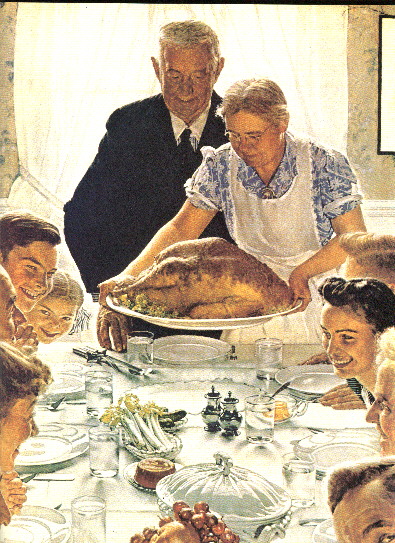
American art from the 1940s
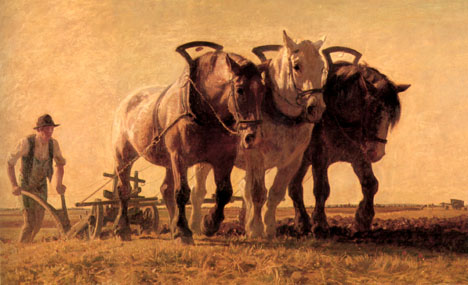
Nazi era Art
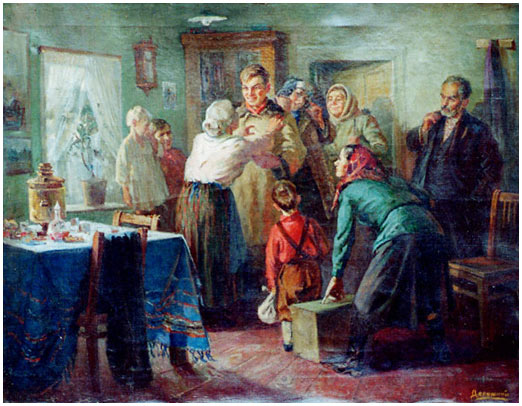
Socialist Realism from Stalin era
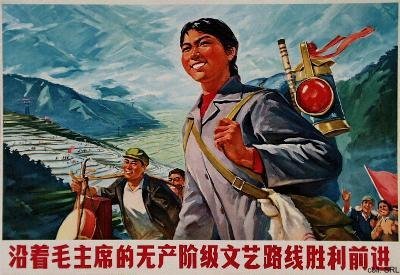
Maoist era Communist Chinese Art
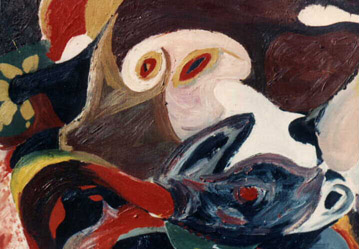
Abstract Art
Art that is favored by the far Left or Right tends to reflect
community, hard work, courage, sacrifice, loyalty, honor, etc.
In this way, the far Left and far Right share a similarity. American
conservatives today often complain about the use of federal money to pay
for "Liberal" artwork such as abstract art and things of that nature.
Realism provides the observer with an interpretation of reality and
conveys an idea to the observer. The interpretation of abstract art
however is said to be "up to the observer". This is why it is embraced
by "individualist" culture, and ultimately why abstract art thrives in
modern capitalist cultures, because capitalism promotes "individuality",
and this is why the far Left supports realism, because the far Left sees
abstract art as ultimately being a product of, and supportive of,
self-centered capitalist culture.
The Right, on the other hand, tends to view things in terms of
"morality". To the Right, weird art is "immoral", body piercing is
"immoral", gangster rap is "immoral". To the Right there are certain
ideas that that are "bad" or "immoral" that people shouldn't think about
or shouldn't express. The Marxist Left is not generally concerned from
this standpoint.
To the Marxist Left, these things may be considered expressions of
objectification and consumerism. From the standpoint of Left criticism,
body piercing is an example of how capitalism causes people view
themselves as objects and seek attention through individualistic
expression because of their lack of a satisfying social bond with their
community, which is caused by alienation and commodity fetishism.
Pornography is another issue where far Left and far Right agree in
principle.
While it may not be fair to state that all those who are
ideologically aligned with the far Right are opposed to pornography,
those who call themselves conservatives generally are. The reason they
often give for this, once again, is that "it's immoral" and "God
says that it's wrong."
To the Marxist Left though, pornography is an example of
objectification of women and the exploitation of women as forms of
capital, i.e. using women as "productive property", as well as a means
to exploit the natural desires of men for profit. So again, to the far
Left pornography is a symptom of a culture based on capitalism and the
objectification of human beings.
For Liberals, however, pornography is perfectly acceptable, just
another form of human expression, and a great way to make money.
It is important to note that the early Communist movement, in the
days of Marx and Engels, was very much in favor of "free love" and a
sexually open society. Expression of sexuality was never opposed and was
in fact encouraged by the Marxists. However, the exploitation of sex as
part of the capitalist system is what was opposed, and thus Marxists
oppose both prostitution and the use of sex in advertising, etc.
One of the areas where Left and Right tend to differ from each other
the most, and perhaps this is the principle that distinguishes Left from
Right the most in both the social and economic sense, is on the subject
of equality.
The Left, fundamentally, is based on striving for human equality,
whereas the Right is either dismissive of the idea of equality or
downright opposed to it. The Liberal position tends to play lip service
to the issue of equality without actually doing anything to promote it.
The founding fathers of America, for an example of Liberalism, played
lip service to equality, yet most owned slaves.
In America those aligned with the Right have done things such as
affiliate with the KKK, which actively opposed racial equality between
whites and non-whites, and said things such as:
Mr. President, we southern people don't believe in no such
stuff as social equality with the negroes as you are doing.
- From a letter to President Franklin Roosevelt
The Nazis obviously had a program based strongly on the idea of
superiority of race and also of dictatorship of an individual
ruler, whom the rest of society was obliged to follow.
Italian fascism, while less racist, was nevertheless just as strongly
based on the idea of supremacy of leadership.
In contrast, as already mentioned, groups such as the Quakers and
Amish were founded on the idea of equality of all of the members of the
society, and were also very supportive of the rights of others, even
outside of their groups. Amish and Quaker societies were, and are,
organized in such a way that everyone in the society is to have an equal
say in the concerns of the group and in planning on how to deal with
problems that the group faces. The Quakers even took special steps in
the 1700s and 1800s to ensure that women would have a stronger voice in
community planning and politics.
Marxism and the Communist movement, too, are based on the idea of
equality, however a number of issues have confused this subject, both
historical facts and anti-Communist distortions as well. Without going
into detail, because it could turn into a whole other topic, it can be
said that ideologically the Left is rooted in the idea of equality, both
of rights to access to material wealth and of social equality of
individuals. What can be said is that the far Left justifies
the use of significant force and exclusionary tactics to secure or
promote equality.
One major concept about equality that is critical to understand is
the difference between the Marxist Left understanding of equality and
the modern Liberal concept of equality. The Marxist Left fundamentally
acknowledges individual inequality, whereas modern Liberalism tends to
claim that individuals are equal. Marxism does not claim that
people have equal abilities, but rather that people deserve equal
benefits of the fruits of society.
But one man is superior to another physically, or mentally, and
supplies more labor in the same time, or can labor for a longer
time; and labor, to serve as a measure, must be defined by its
duration or intensity, otherwise it ceases to be a standard of
measurement.
...
In a higher phase of communist society, after the enslaving
subordination of the individual to the division of labor, and
therewith also the antithesis between mental and physical labor, has
vanished; after labor has become not only a means of life but life's
prime want; after the productive forces have also increased with the
all-around development of the individual, and all the springs of
co-operative wealth flow more abundantly -- only then can the narrow
horizon of bourgeois right be crossed in its entirety and society
inscribe on its banners: From each according to his ability, to each
according to his needs!
- Karl Marx; Critique of the Gotha
Programme, 1875
The Right, however, tends to take the view that individual inequality
legitimizes greater social inequality.
Summary
While the terms "Left" and "Right" are actually somewhat nebulous,
and probably completely outmoded for truly meaningful political
analysis, they do still play a role in popular political discussion and
they do still impact how we view both ourselves and others politically.
Because of this it is important to better understand these terms and the
ideas behind them, even if they are somewhat vague ideas.
The difficulty of labeling individuals or organizations Left or Right
is exposed when discussing groups such as the Amish and Quakers, who in
many ways seem to be Leftists in every regard, both economic and social,
yet at the same time have strong conservative elements as well. The
Amish are not really relevant to the present political spectrum, however
I have included them in this discussion as a point of reference.
America today can defiantly be described as a post-modernist society.
Post-modernism is the essence of Liberal ideology. Post-modernist social
Liberalism in America today serves the interests of corporate America
and is a product of capitalist culture. Post-modernism is effectively
the secular form of anti-Leftism - it is ultimately the true embodiment
of post World War II Liberalism. The "conservative" movement in America
today is greatly misguided because it aligns itself economically with
the interests that contribute to the social conditions that the
conservative movement opposes.
Likewise then, many of the most socially liberal members of society,
who are improperly viewed as being "Leftists" in American popular
politics, are in fact the people who have bought into, and are the most
supportive of, corporate capitalism. Post-modernism creates a
disempowered society of factionalized and atomized individuals with no
grounding in an objective common reality, which is an essential
starting point for any meaningful political movement. Capitalism in
America has both created the existing post-modernist society and
benefits from its continued existence.
Liberal, post-modernist, American society is not "Leftist" in the
least. There is no significant Left in America at all. What is called
the "Left" in America today are either Liberals or Left Fascists, those
who support Leftist social regulation through cooperation with the
establishment Corporate-State. These are not "Leftists".
Understanding the full spectrum of political ideology helps to
provide an understanding of American politics, and helps to illuminate
many of the contradictions in both American politics and American
society.
|